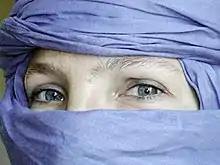Hirschberg test
In the fields of optometry and ophthalmology, the Hirschberg test, also Hirschberg corneal reflex test, is a screening test that can be used to assess whether a person has strabismus (ocular misalignment).
| Hirschberg test | |
|---|---|
 | |
| Synonyms | Hirschberg corneal reflex test |
| Purpose | whether a person has strabismus |
A photographic version of the Hirschberg is used to quantify strabismus.[1]
Technique

It is performed by shining a light in the person's eyes and observing where the light reflects off the corneas. In a person with normal ocular alignment the light reflex lies slightly nasal from the center of the cornea (approximately 11 prism diopters—or 0.5mm from the pupillary axis), as a result of the cornea acting as a temporally-turned convex mirror to the observer. When doing the test, the light reflexes of both eyes are compared, and will be symmetrical in an individual with normal fixation. For an abnormal result, based on where the light lands on the cornea, the examiner can detect if there is an exotropia (abnormal eye is turned out), esotropia (abnormal eye is turned in), hypertropia (abnormal eye higher than the normal one) or hypotropia (abnormal eye is lower than the normal one).
Interpretation
In exotropia the light lands on the medial aspect of the cornea. In esotropia the light lands on the lateral aspect of the cornea. In hypertropia the light lands on the inferior aspect of the cornea. In hypotropia the light lands on the superior aspect of the cornea. A cover test can tell you the extent of the eso/exotropia.
Individuals can suffer from several tropias at once. In Graves ophthalmopathy, it is not uncommon to see an esotropia (due to pathology of the medial rectus muscle) co-morbid with a hypotropia (due to pathology of the inferior rectus muscle).
Krimsky Test
The Krimsky test is essentially the Hirschberg test, but with prisms employed to quantitate deviation of ocular misalignment by determining how much prism is required to centre the reflex [2] The Krimsky test is advisably used for patients with tropias, but not with phorias.
History
The technique was developed by German ophthalmologist Julius Hirschberg who in 1886 used a candle to observe the light reflex in an eye with strabismus.[3]
References
- Eskridge JB, Wick B, Perrigin D. "The Hirschberg test: a double-masked clinical evaluation." Am J Optom Physiol Opt. 1988 Sep;65(9):745-50. PMID 3056019.
- Schwartz, Gary S. (2006-01-01). The Eye Exam: A Complete Guide. SLACK Incorporated. ISBN 9781556427558.
- Wheeler, M. "Objective Strabismometry in Young Children." Trans Am Ophthalmol Soc. 1942; 40: 547–564.